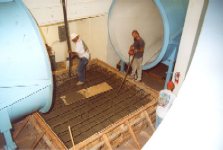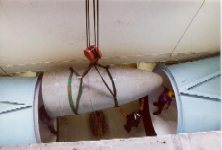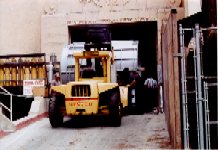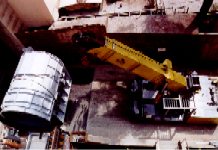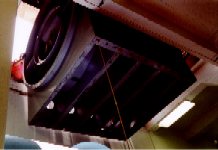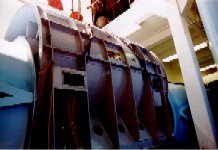|
GRADUATE AEROSPACE
LABORATORIES |
||
| Lucas AWT Home Capabilities Test Requirements Specifications Photos Contact Information Historical AWT Construction
|
Lucas AWT Construction Fan Installation The fan was the last part of the tunnel to be installed. Despite its rugged 1/2" steel plate construction and weight of 30,000 lbs, the fan still needs to be handled with care. The access hole in the ceiling of the wind tunnel room also had to be enlarged specifically to provide clearance for the fan. Once the wind tunnel sections were in place, the concrete fan mounting pad was poured. In addition to elevating the fan to the correct height, the 45,000 lb block of concrete provides a reaction mass for vibration control. The nose and tailcones were set into the sections upstream and downstream of the fan, respectively, for later installation. Lowering the fan into place was a two-step operation. First, a large forklift was used to bring the fan to the top of the ramp. Then, a deck crane was used to lift the fan, move it through the door, and lower it into position. The deck crane is a low-profile crane typically used inside buildings, but the crew at Mammoet cut and welded a new, lower-profile head for the boom to insure that they had adequate clearance to pass through the door. Once the fan was lowered onto the pad, Chris Krok and Jerry Landry aligned it with the tunnel using a combination of rollers and jack screws threaded into the fan's base rails. Six-inch-square steel shim stacks were fitted to the fan's hold down locations, and the fan was anchored by sixteen, one-inch diameter threaded rods epoxied 12" into the concrete. The fan and tunnel ends were connected by rubber strips wrapped around the circumference and clamped in place, to isolate fan vibrations from the tunnel structure. Click on images to enlarge.
|
|
